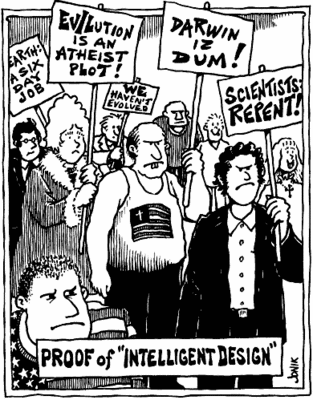Central Tenets of Evolution Theory
New Analyses Bolster Central Tenets of Evolution Theory
Pa. Trial Will Ask Whether 'Alternatives' Can Pass as Science
By Rick Weiss and David Brown
Washington Post Staff Writers
Monday, September 26, 2005; Page A08
When scientists announced last month they had determined the exact order of all 3 billion bits of genetic code that go into making a chimpanzee, it was no surprise that the sequence was more than 96 percent identical to the human genome. Charles Darwin had deduced more than a century ago that chimps were among humans' closest cousins.
But decoding chimpanzees' DNA allowed scientists to do more than just refine their estimates of how similar humans and chimps are. It let them put the very theory of evolution to some tough new tests.
If Darwin was right, for example, then scientists should be able to perform a neat trick. Using a mathematical formula that emerges from evolutionary theory, they should be able to predict the number of harmful mutations in chimpanzee DNA by knowing the number of mutations in a different species' DNA and the two animals' population sizes.
"That's a very specific prediction," said Eric Lander, a geneticist at the Broad Institute of MIT and Harvard in Cambridge, Mass., and a leader in the chimp project.
Sure enough, when Lander and his colleagues tallied the harmful mutations in the chimp genome, the number fit perfectly into the range that evolutionary theory had predicted.
Their analysis was just the latest of many in such disparate fields as genetics, biochemistry, geology and paleontology that in recent years have added new credence to the central tenet of evolutionary theory: That a smidgeon of cells 3.5 billion years ago could -- through mechanisms no more extraordinary than random mutation and natural selection -- give rise to the astonishing tapestry of biological diversity that today thrives on Earth.
Evolution's repeated power to predict the unexpected goes a long way toward explaining why so many scientists and others are practically apoplectic over the recent decision by a Pennsylvania school board to treat evolution as an unproven hypothesis, on par with "alternative" explanations such as Intelligent Design (ID), the proposition that life as we know it could not have arisen without the helping hand of some mysterious intelligent force.
Today, in a courtroom in Harrisburg, Pa., a federal judge will begin to hear a case that asks whether ID or other alternative explanations deserve to be taught in a biology class. But the plaintiffs, who are parents opposed to teaching ID as science, will do more than merely argue that those alternatives are weaker than the theory of evolution.
They will make the case -- plain to most scientists but poorly understood by many others -- that these alternatives are not scientific theories at all.
"What makes evolution a scientific explanation is that it makes testable predictions," Lander said. "You only believe theories when they make non-obvious predictions that are confirmed by scientific evidence."
Lander's experiment tested a quirky prediction of evolutionary theory: that a harmful mutation is unlikely to persist if it is serious enough to reduce an individual's odds of leaving descendants by an amount that is greater than the number one divided by the population of that species.
The rule proved true not only for mice and chimps, Lander said. A new and still unpublished analysis of the canine genome has found that dogs, whose numbers have historically been greater than those of apes but smaller than for mice, have an intermediate number of harmful mutations -- again, just as evolution predicts.
New Analyses Bolster Central Tenets of Evolution Theory
"Evolution is a way of understanding the world that continues to hold up day after day to scientific tests," Lander said.
By contrast, said Alan Leshner, chief executive of the American Association for the Advancement of Science, Intelligent Design offers nothing in the way of testable predictions.
"Just because they call it a theory doesn't make it a scientific theory," Leshner said. "The concept of an intelligent designer is not a scientifically testable assertion."
Asked to provide examples of non-obvious, testable predictions made by the theory of Intelligent Design, John West, an associate director of the Discovery Institute, a Seattle-based ID think tank, offered one: In 1998, he said, an ID theorist, reckoning that an intelligent designer would not fill animals' genomes with DNA that had no use, predicted that much of the "junk" DNA in animals' genomes -- long seen as the detritus of evolutionary processes -- will someday be found to have a function.
(In fact, some "junk" DNA has indeed been found to be functional in recent years, though more than 90 percent of human DNA still appears to be the flotsam of biological history.) In any case, West said, it is up to Darwinists to prove ID wrong.
"Chance and necessity don't seem to be good candidates for explaining the appearance of higher-order complexity, so the best explanation is an intelligent cause," West said.
Simple and Hard
The controversy that has periodically erupted around evolution can be attributed at least in part to the fact that it is both simple to understand and hard to believe.
Charles Darwin and Alfred Russel Wallace, working independently in the early- to mid-1800s, each came up with the concept of "natural selection." Each sought to explain the astounding diversity of life he found in exotic places, Darwin in the Galapagos Islands and Wallace in Brazil.
Their idea was this:
By some accident of nature whose workings neither man could explain, an organism may exhibit a variation in shape, color or body function new to the species. Although most of these new traits are damaging -- probably lethal -- a small fraction actually help. They may make it easier to hide from predators (like a moth's coloration), exploit a food source (an anteater's long tongue), or make seeds more durable (the coconut's buoyant husk).
If the trait does help an organism survive, that individual will be more likely to reproduce. Its offspring will then inherit the change. They, in turn, will have an advantage over organisms that are identical except for that one beneficial change. Over time, the descendants that inherited what might be termed the "happy accident" will outnumber the descendants of its less fit, but initially far more numerous, brethren.
There are two important consequences of this mechanism.
New Analyses Bolster Central Tenets of Evolution Theory
The first is that organisms will tend to adapt to their environments. If the planet's atmosphere contains lots of oxygen but very little methane gas, living things are going to end up tolerating oxygen -- and possibly even depending on it. But do not expect to see many methane-breathers.
This appearance of "perfect fit" makes it seem as if organisms must have been the product of an intelligent force. But this appearance of perfection is deceiving. It gives no hint of the numberless evolutionary dead ends -- lineages that, according to the fossil record, survived for a while but then died out, probably because changes in the environment made their once-perfect designs not so perfect anymore.
The second result of Darwin and Wallace's mechanism is that over time it will create species diversity. As additional "happy accidents" alter an organism's descendants over millions of years, those descendants will come to look less and less like other organisms with which they share a common ancestor. Eventually, the descendants will be able to mate only with each other. They will be lions and tigers -- each a distinct species, but both descended from the same ancient cat.
What is hard to understand about this process is that it is essentially passive. The mechanism is called "natural selection" because the conditions at hand -- nature -- determine which accidents are beneficial and which are not. Organisms do not seek ends.
Giraffes do not decide to grow long necks to browse the high branches above the competition. But a four-legged mammal on the savannah once upon a time was endowed with a longer neck than its brothers and sisters. It ate better. We call its descendants giraffes.
That a mechanism driven by random events should result in perfectly adapted organisms -- and so many different types -- seems illogical.
"Even today a good many distinguished minds seem unable to accept or even to understand that from a source of noise, natural selection alone and unaided could have drawn all the music of the biosphere," Jacques Monod, a French biologist and Nobel Prize winner, wrote in 1970 in the book "Chance and Necessity."
Natural selection was really hard to accept in Darwin's day. But it has become easier with the discovery of genes, DNA and techniques that have made it possible to watch natural selection happen.
DNA is a stringlike molecule made up of paired beads called nucleotides. It carries the instructions for making proteins and RNA, the chief building materials of life. Individually, these instructions are called genes.
The random changes Darwin knew must be happening are accidents that happen to DNA and genes. Today, they can be documented and catalogued in real time, inside cells.
Cells sometimes make errors when they copy their DNA before dividing. These mutations can disable a gene -- or change its action. Occasionally cells also duplicate an entire gene by mistake, providing offspring with two copies instead of one. Both these events provide raw material for new genes with new and potentially useful functions -- and ultimately raw material for new organisms and species.
Richard E. Lenski, a biologist at Michigan State University, has been following 12 cultures of the bacterium Escherichia coli since 1988, comprising more than 25,000 generations. All 12 cultures were genetically identical at the start. For years he gave each the same daily stress: six hours of food (glucose) and 18 hours of starvation. All 12 strains adapted to this by becoming faster consumers of glucose and developing bigger cell size than their 1988 "parents."
The second result of Darwin and Wallace's mechanism is that over time it will create species diversity. As additional "happy accidents" alter an organism's descendants over millions of years, those descendants will come to look less and less like other organisms with which they share a common ancestor. Eventually, the descendants will be able to mate only with each other. They will be lions and tigers -- each a distinct species, but both descended from the same ancient cat.
What is hard to understand about this process is that it is essentially passive. The mechanism is called "natural selection" because the conditions at hand -- nature -- determine which accidents are beneficial and which are not. Organisms do not seek ends.
Giraffes do not decide to grow long necks to browse the high branches above the competition. But a four-legged mammal on the savannah once upon a time was endowed with a longer neck than its brothers and sisters. It ate better. We call its descendants giraffes.
That a mechanism driven by random events should result in perfectly adapted organisms -- and so many different types -- seems illogical.
"Even today a good many distinguished minds seem unable to accept or even to understand that from a source of noise, natural selection alone and unaided could have drawn all the music of the biosphere," Jacques Monod, a French biologist and Nobel Prize winner, wrote in 1970 in the book "Chance and Necessity."
Natural selection was really hard to accept in Darwin's day. But it has become easier with the discovery of genes, DNA and techniques that have made it possible to watch natural selection happen.
DNA is a stringlike molecule made up of paired beads called nucleotides. It carries the instructions for making proteins and RNA, the chief building materials of life. Individually, these instructions are called genes.
The random changes Darwin knew must be happening are accidents that happen to DNA and genes. Today, they can be documented and catalogued in real time, inside cells.
Cells sometimes make errors when they copy their DNA before dividing. These mutations can disable a gene -- or change its action. Occasionally cells also duplicate an entire gene by mistake, providing offspring with two copies instead of one. Both these events provide raw material for new genes with new and potentially useful functions -- and ultimately raw material for new organisms and species.
Richard E. Lenski, a biologist at Michigan State University, has been following 12 cultures of the bacterium Escherichia coli since 1988, comprising more than 25,000 generations. All 12 cultures were genetically identical at the start. For years he gave each the same daily stress: six hours of food (glucose) and 18 hours of starvation. All 12 strains adapted to this by becoming faster consumers of glucose and developing bigger cell size than their 1988 "parents."
When Lenski and his colleagues examined each strain's genes, they found that the strains had not acquired the same mutations. Instead, there was some variety in the happy accidents that had allowed each culture to survive. And when the 12 strains were then subjected to a different stress -- a new food source -- they did not fare equally well. In some, the changes from the first round of adaptation stood in the way of adaptation to the new conditions. The 12 strains had started to diverge, taking the first evolutionary steps that might eventually make them different species -- just as Darwin and Wallace predicted.
In fact, one of the more exciting developments in biology in the past 25 years has been how much DNA alone can teach about the evolutionary history of life on Earth.
For example, genome sequencing projects have shown that human beings, dogs, frogs and flies (and many, many other species) share a huge number of genes in common. These include not only genes for tissues they all share, such as muscle, which is not such a surprise, but also the genes that go into basic body-planning (specifying head and tail, front and back) and appendage-building (making things that stick out from the body, such as antennae, fins, legs and arms).
As scientists have identified the totality of DNA -- the genomes -- of many species, they have unearthed the molecular equivalent of the fossil record.
It is now clear from fossil and molecular evidence that certain patterns of growth in multicellular organisms appeared about 600 million years ago. Those patterns proved so useful that versions of the genes governing them are carried by nearly every species that has arisen since.
These several hundred "tool kit genes," in the words of University of Wisconsin biologist Sean B. Carroll, are molecular evidence of natural selection's ability to hold on to very useful functions that arise.
Research on how and when tool kit genes are turned on and off also has helped explain how evolutionary changes in DNA gave rise to Earth's vast diversity of species. Studies indicate that the determination of an organism's form during embryonic development is largely the result of a small number of genes that are turned on in varying combinations and order. Gene regulation is where the action is.
Consequently, mutations in regulatory portions of a DNA strand can have effects just as dramatic as those prompted by mutations in genes themselves. They can, for example, cancel the development of an appendage -- or add an appendage where one never existed. This discovery refuted assertions by Intelligent Design advocates that gene mutation and natural selection can, at most, explain the fine-tuning of species.
"The mechanisms that make the small differences between species are the same ones that make the big differences between kingdoms," said Carroll, author of a book, "Endless Forms Most Beautiful," that describes many of these new insights.
Although the central tenets of evolution have done nothing but grow stronger with every experimental challenge, the story is still evolving, Carroll and other scientists acknowledge. Some details are sure to be refined over time. The question to be answered in Harrisburg is whether Intelligent Design has anything scientific to add for now, or whether it belongs instead in philosophy class.











